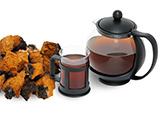There are particular rules about how to gather, dry and store chaga.
It is generally believed that it is possible to harvest birch fungi all year round, regardless of the season.
At first glance, this is indeed the case, due to the fact that chaga is a perennial slow-growing fungus, and because it is well protected from all sorts of external weather influences. But folk experience regarding chaga suggests that it is best to collect the fungus in spring and autumn since the greatest amount of nutrients accumulate during the spring sap flow and autumn preparations for harsh winter days.

There are other particularities in relation to gathering chaga. For example, you should not gather birch fungus from a dry tree due to the fact that, once a tree dies, the chaga thereon also begins to wither and die, giving way to another form of fungus – a fruit fungus. Also, you should never gather chaga from the ground, as it is here, where old, crumbling growths are typically found. It is easy to determine the unsuitability of such outgrowths for medicinal purposes, as they are looser, more crumbly and black across their thickness. There are also other subtleties that must be considered when gathering fungus.
Rules for Gathering Chaga
- Chaga can be harvested all year round, but it is best to do this in spring, specifically in April, or else in autumn, from September through to November.
- Upon heading to the forest to gather chaga, you need to take an axe or, in extreme cases, a large sharp knife because it is really very difficult to separate the outgrowths from the trunk.
- You should only gather chaga growing on birch trees. It is generally believed that the chaga mushrooms with the largest number of nutrients are those living on trees growing in a birch grove, while birch fungus growing on separate trees tends to have fewer nutrients.
- Do not collect chaga from dry, fallen trees or those that are very old.
- Do not gather outgrowths that are near to the ground. The higher up birch chaga is found, the better.
- Old, crumbling chaga outgrowths and growths that are completely black inside are not suitable for medicinal purposes.
- It is most comfortable to cut chaga vertically, near to its trunk and parallel to it.
Treating Gathered Chaga
Once chaga outgrowths have been separated from the trunk, they should be treated in a certain way. The reason for this is that not all parts of a birch fungus are equally useful as a medicament, and, while there are many nutrients in one part of the fungus, they are virtually absent in the others. How can these useful parts be determined? It turns out that the least useful parts are the light-coloured and loose parts of the fungus, located adjacent to the trunk. You should get rid of these parts, as well as all sorts of chips and pieces of birch bark, directly there in the forest.
You only need to leave the solid parts of the fungus – the outer and middle parts. It is best to immediately cut up the gathered raw material into small pieces, right next to the tree.
Then the fresh chaga should be dried, but even here, there are also some subtleties. The fact is that fresh chaga mushroom is easily exposed to mould; thus, is should not be dried in an area that is too damp, cold or poorly ventilated. In any case, you should not attempt to dry chaga more quickly in a hot oven either; otherwise, it will lose most of its biologically active nutrients. Therefore, it is necessary to find a middle ground – you must choose a dry, warm, well-ventilated place. As well, it is necessary to cut the fresh chaga into pieces that are no more 3-6 cm and dry it until the pieces become hard and crumbly. Well-dried birch chaga should be put into glass jars with tight-fitting lids, and can also be packed in sealed paper or linen bags. Chaga that has been properly harvested, prepared and stored retains all its medicinal properties for a period of two years.






